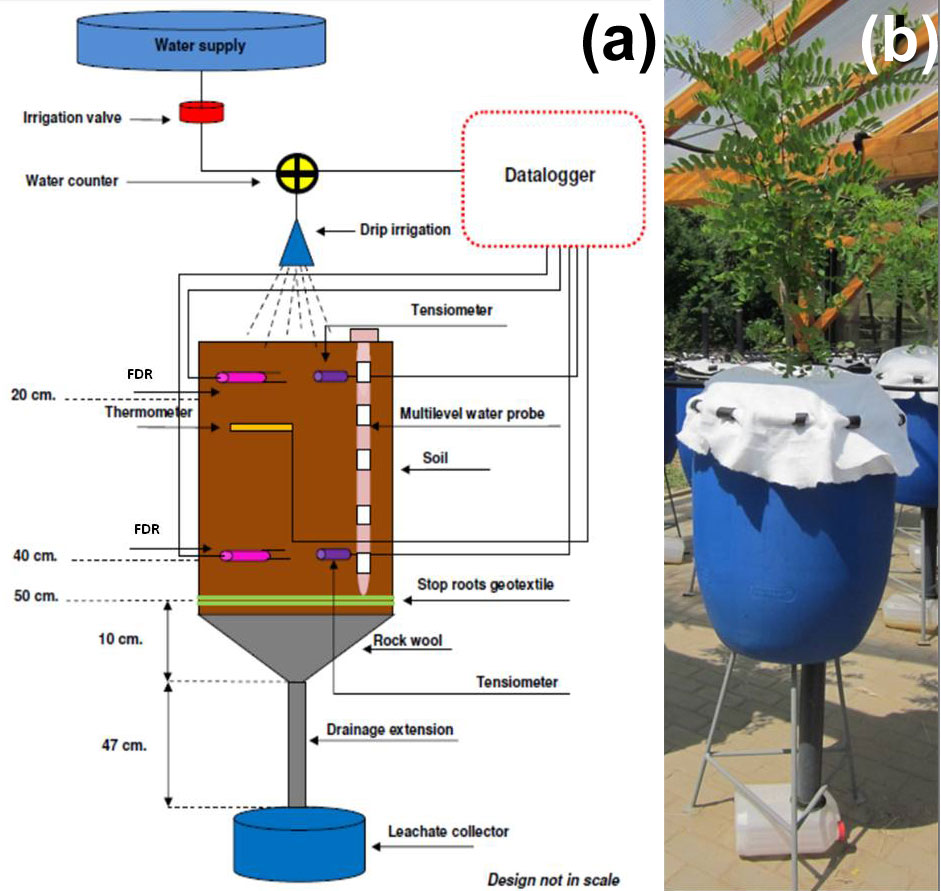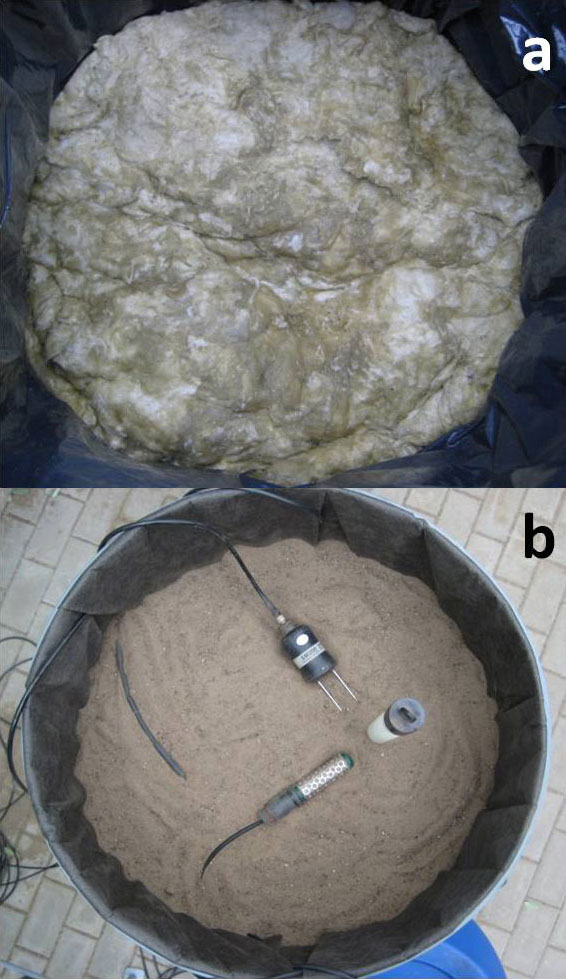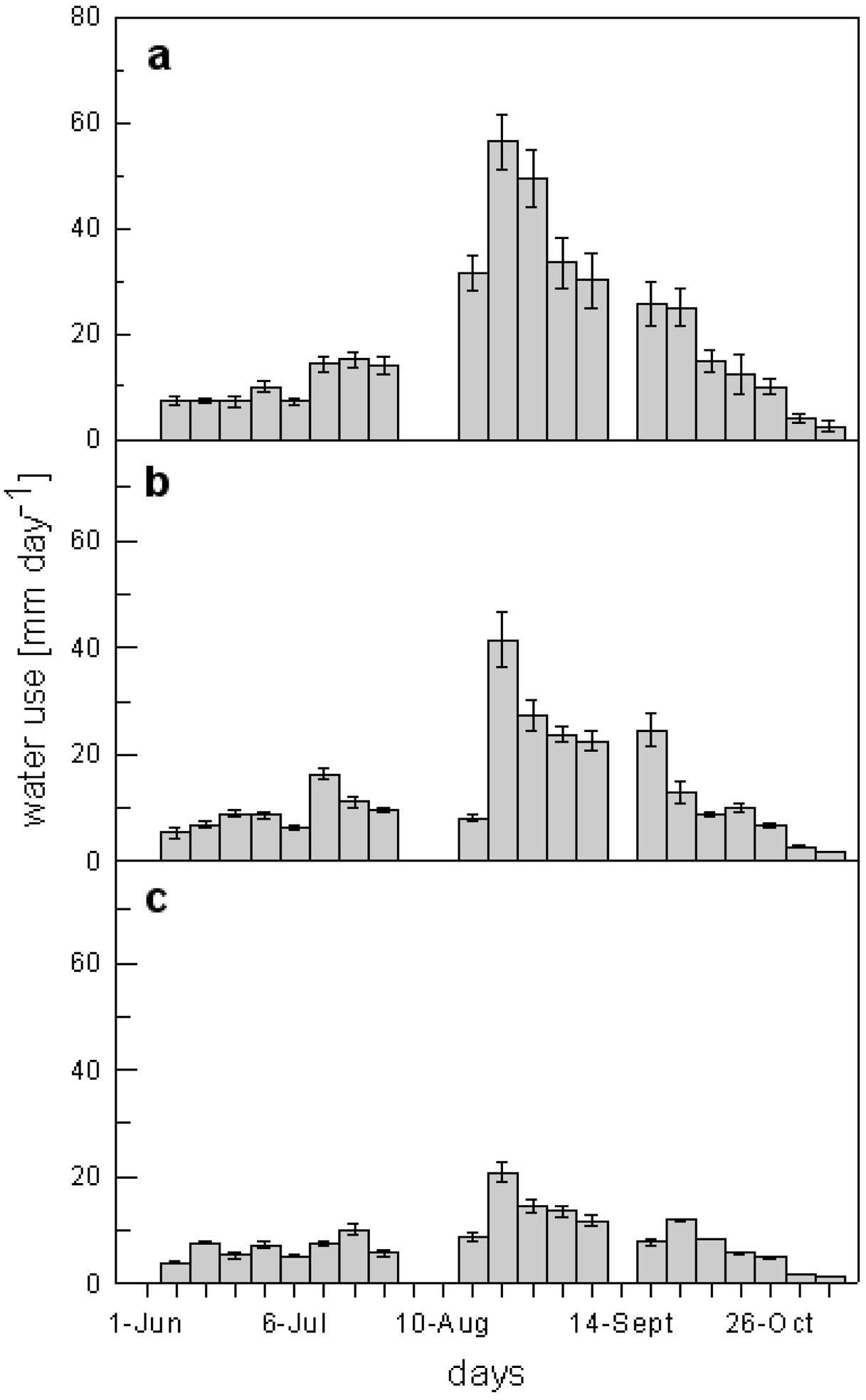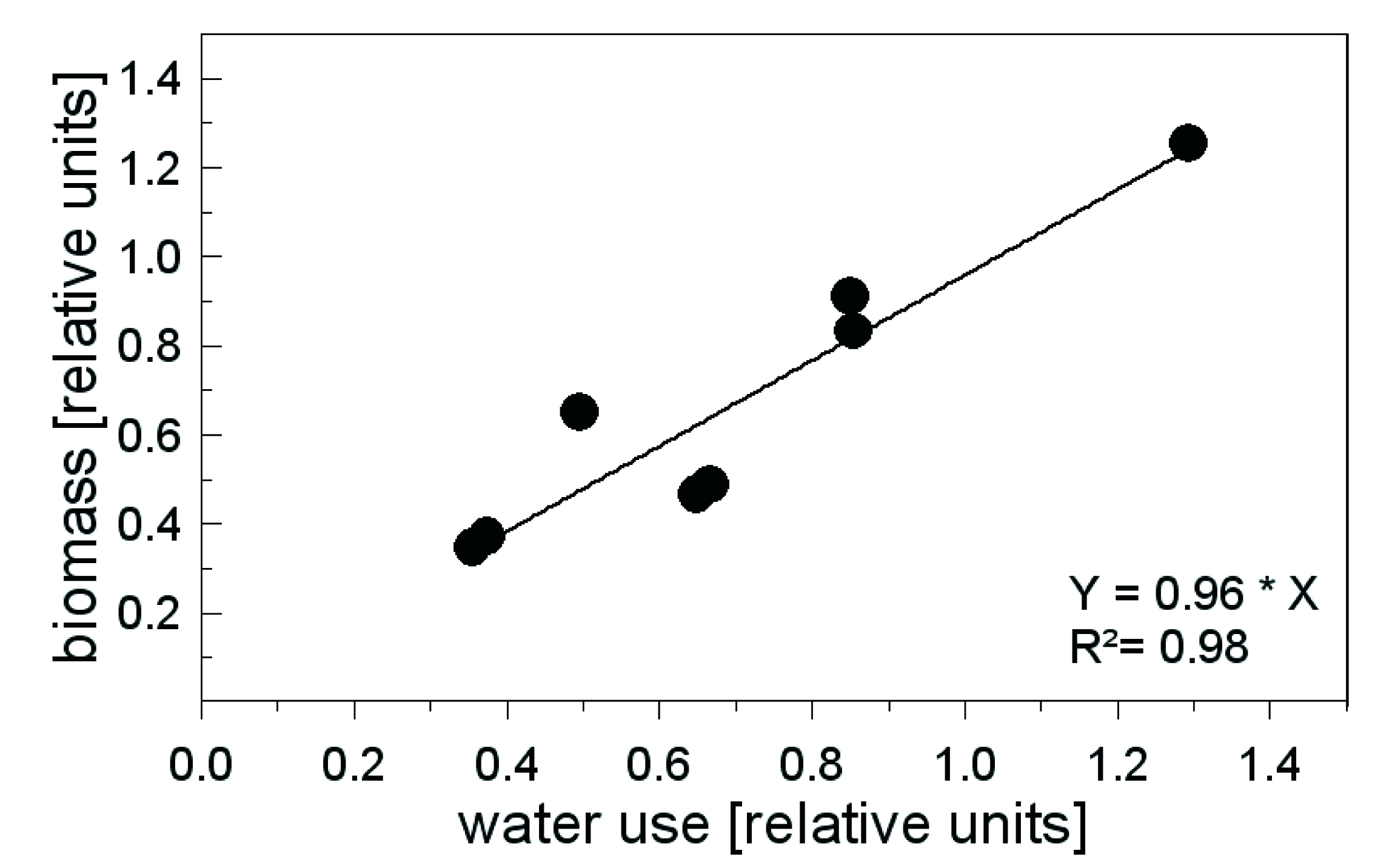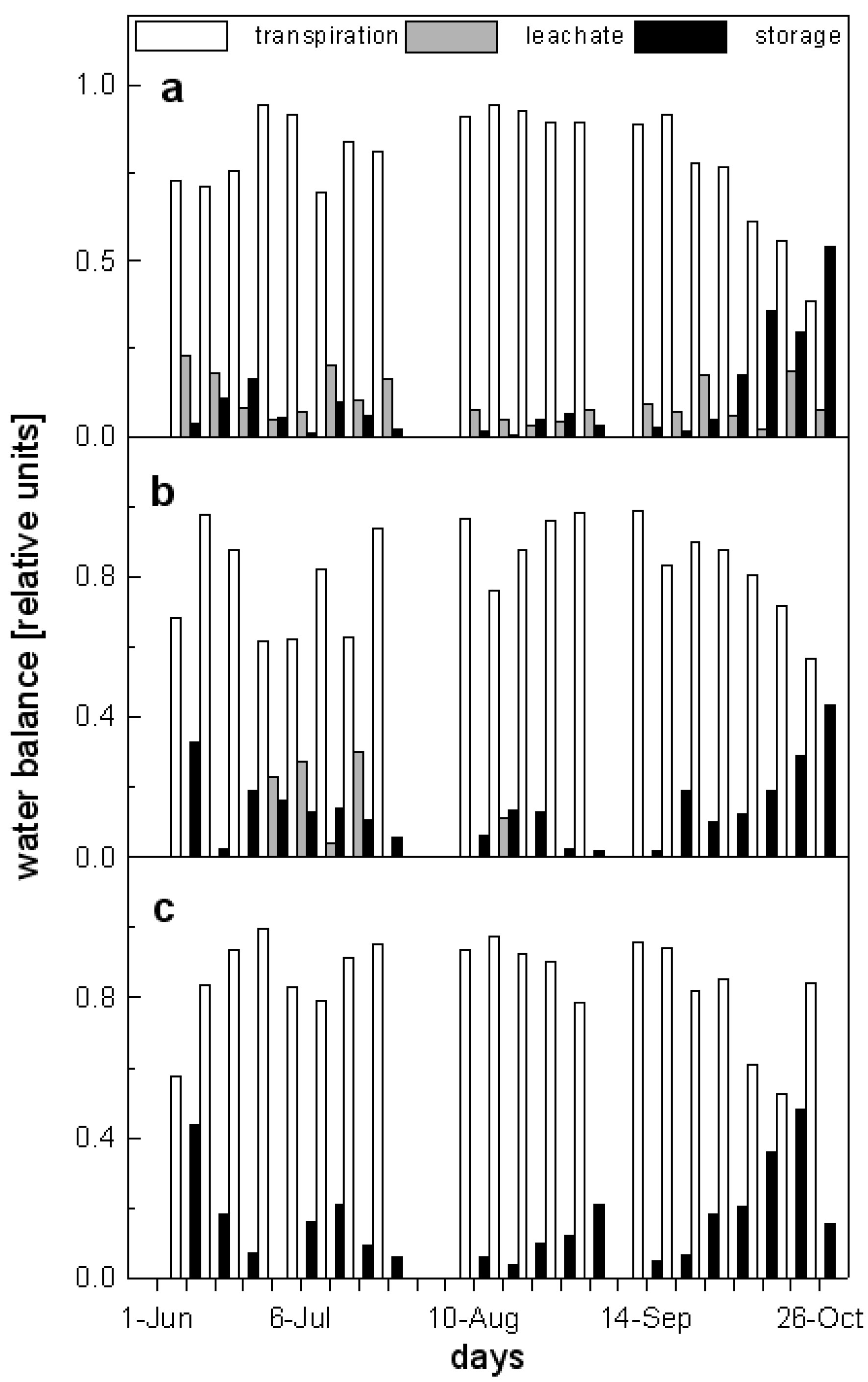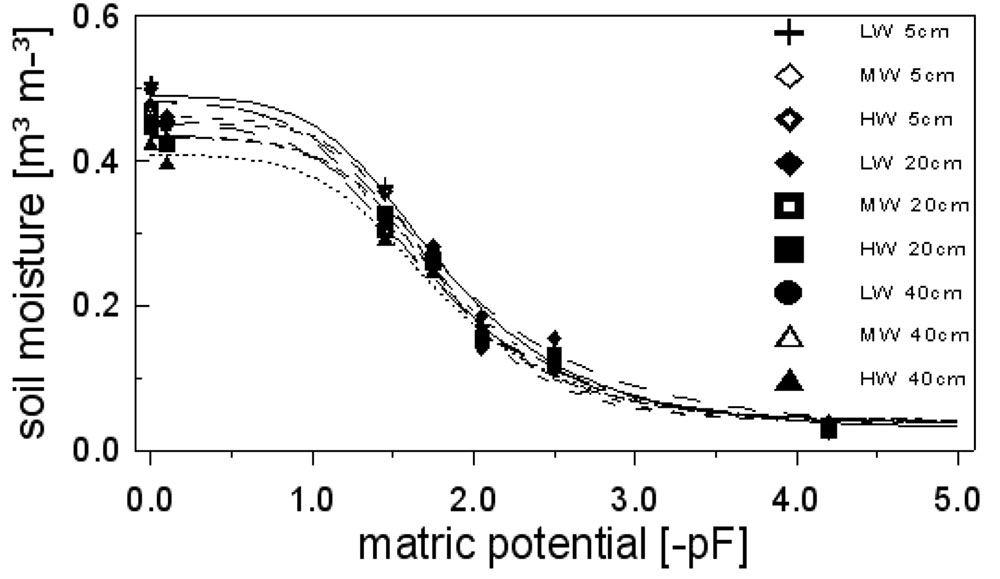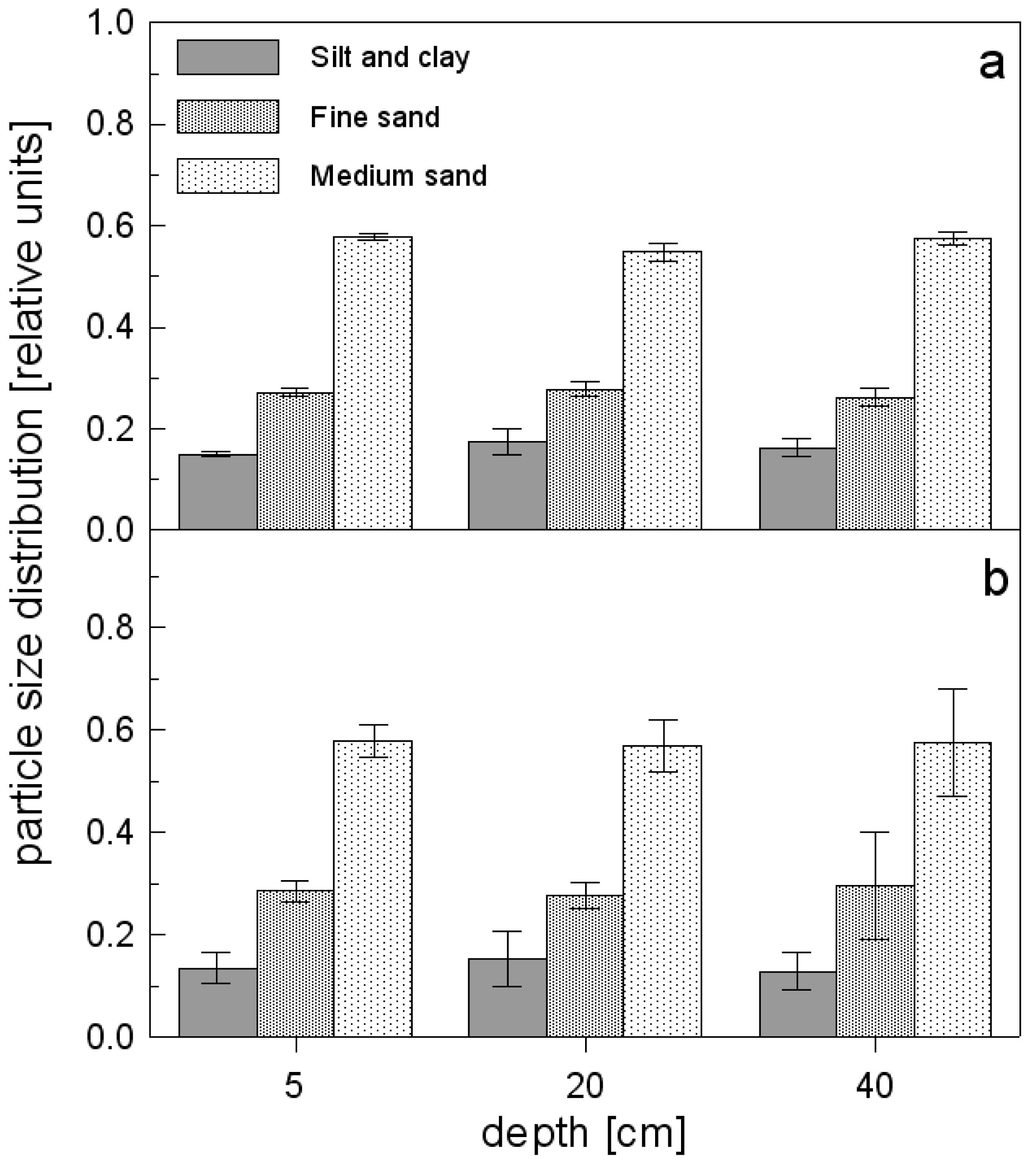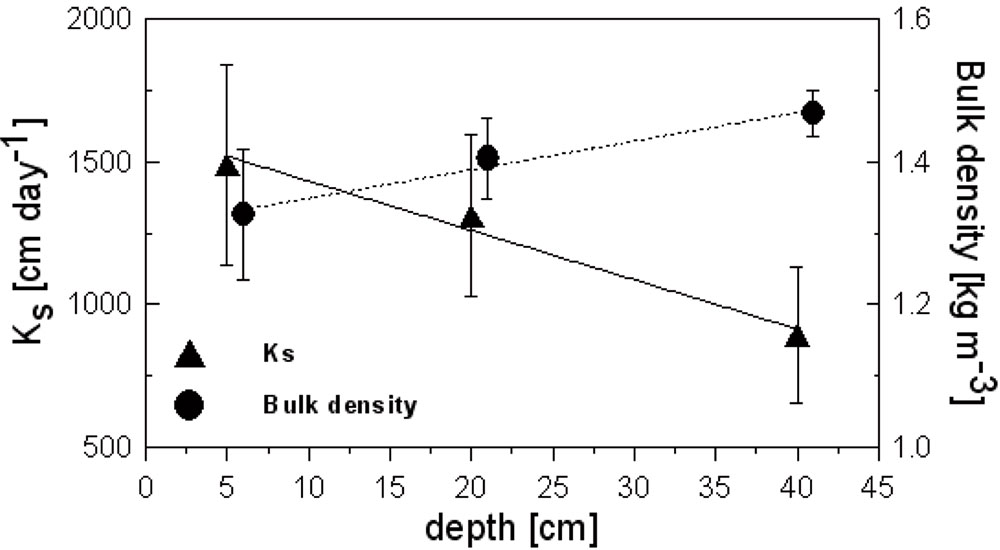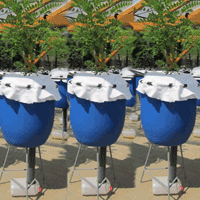
Evaluation of fast growing tree water use under different soil moisture regimes using wick lysimeters
iForest - Biogeosciences and Forestry, Volume 6, Issue 4, Pages 190-200 (2013)
doi: https://doi.org/10.3832/ifor0100-006
Published: May 08, 2013 - Copyright © 2013 SISEF
Research Articles
Abstract
The cultivation of fast growing trees has high potential for bioenergy production on marginal lands. Information about the water use efficiency in combination with the ecophysiological response to drought stress is still incomplete. For the study of the transpiration-biomass relations satisfactory results can be obtained under controlled conditions by using lysimeters. Nonetheless, several technical problems related to the manufacturing can bias the outcome. Pan lysimeters are economical and relatively easy to assemble, however, saturation at the lower boundary can happen. On the other hand tension lysimeters, where the suction is applied by a vacuum pump, are effective but expensive and need constant maintenance. To avoid stagnancy and reduce production costs we assembled a tension controlled wick lysimeter, where the tension at the bottom layer is actively exerted by a hanging water column through the wick material (rockwool). We aim to assess the performance of the wick lysimeter coupled with an automatic irrigation system for the study of water use-yield relation black locust (Robinia pseudoacacia L.) under different irrigation regimes. The volumetric soil content for each treatment, namely low water (LW), medium water (MW) and high water amount (HW), was maintained at 0.07, 0.14 and 0.2 m3 m-3 respectively. During the vegetation period (161 days) the plants growing at LW reduced their water use by 60%, their leaf area by 40% and the total above ground biomass by 46%. As a result, we found a linear correlation (R2 = 0.98) between the relative biomass produced and the relative water use. The calculated relative water use efficiency (RWUE) for black locust total above ground dry biomass is 0.96. Furthermore, after the harvest we evaluated the effectiveness of the lysimeter and irrigation system: the soil moisture of the treatments was kept up at the predefined values and an unsaturated condition at the boundary layer was maintained throughout the vegetation period. Because of the improved design no roots grew into the drainage extension and no unexpected change of the lysimeters hydraulic property occurred. Considering the relatively low-cost material used and the low maintenance needed, compared to other tension controlled lysimeters, wick lysimeters are effective tools for forestry studies of young trees.
Keywords
Black Locust, Soil Moisture Dynamic, Unsaturated Conditions, Hydrostatic State, Wilting Point, Relative Water Use Efficiency
Introduction
Production of renewable energy in line with the CO2 emission and fossil fuel reduction policy over the last decades has been strongly promoted worldwide. Among different possible sources of raw material for bioenergy production, short-rotation plantations can be a valuable choice for marginal land where conventional agriculture is not effective ([11]). In our work we investigated the tree species black locust (Robinia pseudoacacia L.), widely used for short-rotation forestry and agroforestry systems for biomass production in East Germany and Hungary ([34], [5], [28], [10], [36]). Despite the fact that black locust has the potential to become an important tree species for short-rotation plantation in Central and Eastern Europe, the work done in relation to its water use efficiency (WUE) is rare. In our studies the response of black locust to the soil water availability and the atmospheric evaporative demand, in terms of water use and biomass production, is investigated at whole plant level. Since the biomass production depends directly on the climatic conditions and soil water availability ([31]), the study of the intertwined relation between soil moisture, microclimatic boundary conditions and growth response is crucial ([25]), particularly in terms of biomass production and water consumption in relation to photosynthesis and CO2 uptake regulated by the stomata ([30]). Hence the knowledge of the water use ([17]) is a key issue for understanding the processes between soil and plant, especially on marginal lands ([18], [6]), where the water availability is often erratic. In order to minimize the numerous variables involved, the experiment is carried out under semi-controlled conditions by using lysimeters. In addition, to reduce the complexity of the comparison with other case studies, due to the inhomogeneity of the methodology ([33], [21], [4]) and the experimental conditions, the water use efficiency in our investigation is expressed in relative terms (RWUE). The construction of the lysimeters involves several technical issues that could seriously bias the results of the experiment ([19]); however, satisfactory outcomes for agronomic and forestry investigation have been achieved ([29], [41], [22]). There is a wide set of solutions for lysimeter and monitoring systems ([7], [8], [2]), which are tightly related to the scope of the investigation and the project funding. As a consequence, dimension, localization, time scale and maintenance costs of the lysimeters are essential factors to be taken into account. Zero-tension lysimeters are relatively economical, easy to build, and need low maintenance, which allows the user to increase the number of replicas. However, stagnancy at the bottom layer can occur ([1]) with the consequence of anaerobiosis conditions at root level ([16]), which can affect the ecophysiological response of the trees. That risk can only be minimized with the construction of relatively deep lysimeters, where no roots are growing at the bottom layer. Otherwise, water accumulation at the bottom layer can be prevented by using a tension controlled lysimeter, in which the tension is actively exerted by porous plates, cups or candles connected to a vacuum pump. Nonetheless, the costs of the systems are rather elevated, and therefore their use is often limited by the budget of the investigation. They further require high technical maintenance; in addition the pumps need power supply, which is a supplementary impediment, when the installation is in secluded areas. An acceptable compromise between the two extremes of lysimeter typology is the tension controlled wick lysimeter ([40]), where the stagnancy is avoided by constant suction performed by a hanging water column through the wick material ([12], [3]). The improved drainage efficiency of the wick lysimeter against the zero-tension lysimeter has already been described in a critical comparison ([42], [20]). Because of their relatively low-cost construction material, easy installation and independence from power supplies, wick lysimeters are particularly suitable for remote sites and allow the increase of numbers of replicas. Our wick lysimeters are coupled with an automatic drip-irrigation system and a wireless data acquisition system, which allow controlling and monitoring the soil moisture dynamics and water supply via internet connections. The aim of the experiment is to test the performance of the newly developed wick lysimeter for the evaluation of biomass-water use relation of young trees. More in detail we verify: (a) the effectiveness of the wick material on maintaining a constant unsaturated condition at the bottom layer; (b) that unwanted changes of the wick lysimeter hydraulic property due to a translocation do occur; (c) the efficiency of the new automatic irrigation system in maintaining the soil moisture at predefined values; and (d) the suitability of the novel application for stopping roots growing into the wick material. For all the duration of the investigation, the lysimeter has fulfilled our expectations. The link between water availability and the biomass investigated and all other results are satisfactory. The hydraulic properties of the lysimeters have been verified after the experiment, and no unpredicted changes have occurred. The soil water content of the different treatments has been maintained at the predefined values and no stagnancy at the lower boundary happened, for all the duration of the experiment.
Material and methods
Plant material
Two-year-old black locust trees (Robinia pseudoacacia L.) were collected from a short rotation coppice in the re-cultivated post-mining area in Welzow-Süd (20 km south of Cottbus, Brandenburg, Germany) in November 2010. Before digging out the trees, the main branches were cut back at approx. 10 cm from the trunk. The plants were established into 15 L plastic pots, and settled in a protected area during the winter to avoid damages from frost. In March 2011 the plants were transplanted into the wick lysimeters and fertilized with 1045 ml of Hoagland standard solution and 3.18 g (equivalent to 40 kg ha-1) of monopotassium phosphate (KH2PO4). To facilitate a successful establishment of the trees, the plants were maintained at well-watered conditions for two months before starting water treatments.
Biomass measurements
At the end of the experiment the new branches and the leaves were harvested separately and oven-dried at 65 °C until a constant dry weight. To quantify the water limitation effects the values of the soil moisture, the total above-ground biomass production, the total leaf area, and the water use efficiency are expressed in relative terms, considering the maximum mean value equal to one and referring all the other values to it. The relative total above-ground biomass production was calculated by adding the estimated values of the trunk mass increment to the harvested biomass. The relative total leaf area was estimated at the harvest, multiplying the total leaf weight for the weight-area index (kg m-2), obtained from representative samples (n=80). The relative water use efficiency (RWUE) of the trees was calculated by the ratio between the mean of the relative total above-ground dry biomass produced and the mean of the relative cumulative water used during the vegetation period. In order to test the differences between the variables, a non-parametric Mann-Whitney U-test (two independent samples) was applied.
Lysimeters
The wick lysimeter was filled at bulk density mean of 1.3 kg m-3 with homogenized sandy loam soil, relatively low in carbon and nitrogen content, namely 1.33 and 0.08 kg kg-1 respectively, previously sieved with a 2000 μm mechanic sieve. For the construction of the chambers we used standard polyethylene drums of 50 cm diameter and 70 cm height (Fig. 1). To facilitate the drainage, the bottom was funnel-shaped with gravel and adapted for the connection with the highly conductive drainage extension, which exerted constant suction at the lower boundary. The drainage extension consisted of a 6.5 x 47 cm rigid polyethylene pipe filled with rockwool (Sonoroll 035, Deutsche Rockwool, Gladbeck, Germany), with a density of 0.18 kg m-3. The extension drainage dimension and the rockwool density were selected in relation to soil type, column dimension, and the hydraulic property of the specific wick material, following the theoretical consideration formulated by Ben-Gal & Shani ([3]). A 5 cm rockwool layer was befitted between the soil bottom layer and the lysimeter base and connected to the drainage extension (Fig. 2a). To prevent roots from growing into the rockwool a root-stop permeable geotextile (Landschaftsvlies, Delta, Herdecke, Germany) was installed at the soil-rockwool interface (Fig. 2a). At the end of the experiment the lysimeters were emptied and the integrity of the root-stop geotextile and the rockwool were verified. The soil moisture (m3 m-3) and the soil matric potential (hPa) variation was measured on an hourly basis at 20 and 40 cm depth along the soil profile by FDR sensors (SM-200, Frequency Domain Reflectometry, Soil Moisture Sensor Delta-T Devices, Cambridge, UK) and gypsum tensiometers (SIS, UMS, München, Germany), respectively (Fig. 2b). In order to evaluate the water status of the soil column, for the calculation of the weekly changes in water storage, during the filling process a 2.5 x 50 cm fiberglass access tube (Delta-T Devices, Cambridge, UK) was installed into each wick lysimeter. It allowed the soil moisture measurement along the soil profile in 10 cm intervals by the insertion of a portable FDR profile probe (PR2/4w-02, Delta-T Devices, Cambridge, UK). The soil temperature was monitored hourly by a thermistor (SKTS 200, Skye Instruments Ltd, Powys, UK) installed at 20cm depth (Fig. 2b). Due to cost cutting reasons, only one lysimeter for each treatment was monitored with the FDR and gypsum tensiometer, whereas the replicas were equipped only with the fiberglass access tubes and monitored weekly. Water was supplied solely by an automatic drip irrigation system, at a rate of 38 mm h-1, and its amount depended on the differences between the actual soil moisture measured by the FDR sensor installed at 20 cm depth and the predefined value. To avoid uncontrolled water input, the wick lysimeter system was installed under a light transmissive roof. The daily applied water volume (mm) was measured by an electronic flow meter and recorded. Leachate was collected from the drainage extension into polyethylene tanks and measured. The evaporation was minimized to nearly zero by covering the soil with a double layer of turf. Microclimatic parameters were measured and recorded on an hourly basis as follows: air temperature and relative humidity were measured by a thermistor-hygrometer (HC2-S, Rotronic AG, Bassersdorf, Germany), photosynthetically active radiation by a PAR sensor (QS2, Delta-T Devices, Cambridge, UK) and wind speed by a switching anemometer (A100R, Vector Instruments, Rhyl, UK). All the data collected from the wick lysimeter sensors and from the meteorological station were stored on data loggers (GP1, Delta-T Devices, Cambridge, UK). All data was transferred with a GSM wireless data transmission to an internet platform (WEBVis, Umweltanalystische Produkte GmbH, Cottbus, Germany).
Fig. 1 - Schematic diagram (a) and overview (b) of the wick lysimeter and automatic irrigation system.
Fig. 2 - (a) Rockwool installation at the lysimeter bottom; and (b) FDR, tensiometer, and thermistor sensors in the lysimeter.
Water treatments
The experimental design consists of three treatments with three replicates. The different treatments, namely low water amount (LW), medium water amount (MW), and high water amount (HW), were maintained at soil moisture mean of 0.07, 0.14, and 0.2 m3 m-3 during the experiment from June 1st to November 8th, 2011. The upper limit (0.2 m3 m-3) corresponds to the hydrostatic state of the soil column in the wick lysimeter, therefore the plants developed without water limitation (pF ≥ -2). The lower limit (0.7 m3 m-3) was close to the wilting point value of the plants (pF ≤ -3.5). A dry packing refilling of the lysimeters was chosen in order to avoid heterogeneity and preferential flows ([24]). In the columns a discrete quantity of soil was damped every 5 cm and successively packed with a 1 kg wooden pestle. After filling the wick lysimeters to further the particle settling, the soil columns were subjected to wetting-drying cycles over a period of one month before planting. To monitor a possible translocation of the smaller soil particles (< 63 μm) and colloids ([38]) through the soil profile, as a consequence of intensive irrigation, the particle size distribution (PSD) was evaluated before the experiments and after the vegetation period. We chose three granulometric classes, namely medium sand (2000-200 μm), fine sand (200-63 μm) and a sum of silty and clay fraction (< 63 μm). In order to maintain the colloids within the fine particles category (< 63 μm), no pre-treatment (H2O2 and HCL for the destruction of the organic carbon and carbonates respectively) was applied to the soil, but pyrophosphate dispergation. We made use of the wet sieving method, utilizing a set of sieves with mash of 200 μm and 63 μm. The particles retained in the set of sieves, and the mixture obtained was oven-dried at 105 °C, till a steady state was reached, and then they were weighed. To detect a possible a translocation effect, we compared the silt and clay fraction at different depths before and after the experiment with the Mann-Whitney U-Test, since the normality test failed. The saturated hydraulic conductivity was determined in undisturbed soil cores (100 cm³) taken from three lysimeters at the depths of 5, 20 and 40 cm in four replicates. We chose the permanent-head method using a lab permeameter (Eijkelkamp, Giesbeek, Netherlands). After measuring the bulk density of the same cores was determined by drying them at 105 °C till a steady state. The water retention curve of a soil type describes the relation of volumetric soil moisture and matric potential at steady state conditions. For the indirect method, we used four undisturbed soil samples (100 cm³) from three lysimeters at three depths (5, 20 and 40 cm). The cores were saturated and subsequently equilibrated at increasing matric potentials in steps from 10 to 300 hPa, using ceramic plates. The samples were weighed at every step to determine the volumetric water content. The van Genuchten equation ([39]) was fitted to the data in order to derive a continuous curve. To enhance the accuracy of the FDR-probes we conducted the standard calibration procedure according to the manual (SM-200, Delta-T Devices, Cambridge, UK), using twelve undisturbed soil samples taken from the lysimeters at three depths (20 and 40 cm), and equilibrated them to three moisture levels (0.09, 0.15, and 0.28 m3 m-3). The sensor signal from the samples was corrected according to the actual volumetric water content by modifying the underlying conversion equation. The procedure accounted for both sensor and soil specific inaccuracies. Sensor calibration processes involve some degree of disturbance in the soil column, which were avoided by carrying out the experiment in relative terms, and define the absolute values only at the end of the experiment, after the sensor calibration. For the gypsum tensiometers instead, the calibration resulted more complicated because of the relatively long period of time before the sensor reaches the equilibrium with the surrounding soil and for its inaccuracy. Consequently we used the water retention curve (pF curve) obtained with the indirect method to link the matric potential values at any given soil moisture.
Water balance
The weekly water use was obtained from the terms of the experimental water balance after eqn. 1:
where T is the tree transpiration, I the irrigation, E the evaporation, Le the leachate, and ΔS the water storage variation. Evaporation from the lysimeters was minimized, covering the soil surface with fleece, thus E can be set to 0 in eqn. 1.
Results
Plants
During the growing season, the soil moisture of the three different treatments was maintained within the preconceived values of 0.07, 0.14, and 0.2 m3 m-3, by irrigating the plants only when the soil moisture value was below the fixed limits (Fig. 3). As a response to the water limitation, the LW plants reduced their transpiration rate by 60%, in comparison to the HW plants. The mean cumulative water used (mm) for each treatment during the vegetation period is shown in Fig. 4, where the water used during the growing season is related to the relative soil water availability. The plants in the different treatments used the water at different rates during the vegetation period. In Fig. 5 the three phases of the growth are displayed (Tab. 1): (i) beginning from June 1st to July 6th, where for all the treatments the rate was under 10 mm day-1; (ii) the peak from July 6th to September 15th, where all the plants reached the maximum rate; and (iii) the decline phase, characterized by a decrease of the rate, till reaching the minimum at the end of the vegetation period (from September 15th to November 8th). During the peak period, the LW plants reduced the transpiration significantly, by 42% and 61% as compared to the MW and HW, respectively. Conversely, no differences between the treatments were found at the beginning and the decline periods. Water limitation caused the reduction of the transpiring surface and the biomass production. At the end of the growing period the total leaf area of the LW plants was reduced by 30% and 60%, compared to the MW and HW, respectively (Fig. 6a). The LW biomass production instead was reduced by 4% and 53% compared to the MW and HW treatments, respectively (Fig. 6b). We could calculate a linear relation (R2 = 0.98) between the above ground biomass and the water use (Fig. 7). The calculated relative water use efficiency (RWUE) for black locust total above ground dry biomass evaluated at the harvest was 0.96, and the difference between the treatments is not statistically significant.
Fig. 3 - Mean daily soil moisture in the lysimeters for low (LW), medium (MW) and high water (HW) amount, measured at 20 cm (panel a) and 40 cm (panel b) depth during the experiment from June 1st to November 8th, 2011.
Fig. 4 - Mean and standard deviation of the cumulative water use in relation to the relative soil water availability measured during the experiment from June 1st to November 8th, 2011. Treatments labeled with the same letter are not significantly different (p ≤ 0.05), after non-parametric Mann-Whitney U-test (two independent samples).
Fig. 5 - Means and standard deviation of te water use measured during the vegetation period from June 1st to November 8th, 2011. (a): High water amount (HW); (b): medium water amount (MW); (c): low water amount (LW).
Tab. 1 - Transpiration rate means in relation to the different periods of the growing season (from June 1st to November 8th). (*): Across the period of the vegetation season, numbers labeled with the same letters are not significantly different (p 0.05) after non-parametric Mann-Whitney U-test (two independent samples). Within the period vegetation season: numbers labeled with the same symbol are not significantly different (p ≤ 0.05).
| Period | *LW mean (mm day-1) |
Std (mm day-1) |
*MW mean (mm day-1) |
Std (mm day-1) |
*HW mean (mm day-1) |
Std (mm day-1) |
|---|---|---|---|---|---|---|
| beginning | 5.91 a | 1.56 | 7.23 a | 1.54 | 7.79 a | 1.21 |
| peak | ◊ 10.98 b | 4.25 | ♦ 18.77 b | 10.29 | ♦ 28.16 b | 14.35 |
| decline | 3.43 c | 2.19 | 5.34 a | 3.79 | 8.69 a | 5.36 |
Fig. 6 - Means and standard deviations of the relative (a) leaf area and (b) total above ground dry biomass measured at the harvest (November 8, 2011). Treatments labeled with the same letter are not significantly different (p 0.05) after non-parametric Mann-Whitney U-test (two independent samples).
Fig. 7 - Relationship between the mean relative total above biomass production and the mean relative cumulative water used, measured at the harvest (November 8th, 2011).
Lysimeter performance
Even with a certain degree of fluctuation, due to the faster soil moisture dynamics, the method was effective for the differentiation of the treatments (Fig. 4) when compared to a system without boundary. Soil moisture dynamics for all the treatments are shown in Fig. 3. After the initial stage of abundant irrigation, which facilitated the plant establishment and where the soil moisture value at both depths was > 0.15 m3 m-3 (pF ≥ -2), we distinguished a reduction of the soil moisture also at the bottom layer. As expected from the hydraulic characteristics of the lysimeter, the drainage extension was efficient and no stagnancy at the bottom layer occurred. For all the treatments the soil moisture at the lower boundary was always lower than that at the upper layer. Also roots growing into the extension drainage were successfully avoided. No damages to the root-stop geotextile from root penetration were detected after the inspection, and no roots were found in the extension drainage. More accurate information with reference to the soil moisture distribution (every 10 cm) was obtained by inserting the FDR profile probe periodically into the fiberglass access tube. The trends of the obtained values by the FDR profile probe measured at 20 and 40 cm depths, matched up with the soil moisture values obtained by the FDR sensors installed at the same depths (20 and 40 cm). After the calibration of the sensors and the validation of the data, the FDR profile probe was particularly useful for the evaluation of the storage variation along the soil profile for the weekly water budget estimation (Fig. 8). The total volume of leachate produced decreased from the HW plants (approx. 15% of the irrigation) to the MW (approx. 2% of the irrigation), till no leachate at all for the LW. Less effective was the use of the gypsum tensiometers. The information we acquired, linking the soil moisture to the actual soil water availability, was biased. As a result, making use of the direct method for the soil water retention curve determination after Kutílek & Nielsen ([17]) by using FDR sensors coupled with tensiometers, was not possible. The FDR response to the soil moisture variation was faster than the gypsum tensiometer response, and a hysteresis between both sensors was observed, depending on the soil wetting and drying. Consequently, the relation between the soil water availability and the soil moisture was indirectly estimated (Fig. 9). The particle size distribution did not change significantly across the profile after the investigation (Fig. 10). We witnessed a redistribution of the particle size, and the variance between the categories was higher, compared to the situation before the experiment. However, by applying the Mann-Whitney U-Test, the difference was not significant. More in detail, enrichment in fine particles, imputable to a translocation, occurred at 20 cm depth; however, it is not significant (Tab. 2). As expected and verified after the investigation, a settlement of the soil particles occurred resulting in a variation of the saturated hydraulic conductivity (Ks) and the bulk density along the soil profile (Fig. 11). The bulk density increased and the Ks decreased significantly with increasing depth (Tab. 2).
Fig. 8 - Relative weekly experimental water balance for treatments (a) high water amount (HW), (b) medium water amount (MW), (c) low water amount (LW), estimated during the experiment from June 1st to November 11th, 2011.
Fig. 10 - Particle size distribution evaluated at 5, 20 and 40 cm depth at the beginning (a) and at the end (b) of the experiment.
Tab. 2 - Soil properties and silt and clay (including colloids) content mean, measured at different depths (5, 20, and 40 cm) after the experiment. (*): Parametric ANOVA and post-hoc multiple comparison Tukey HSD test; (**): parametric Welch robust test and post-hoc multiple comparison Games-Howell test; (***): non-parametric (two independent samples) Mann-Whitney U test. Numbers labeled with the same letters are not significantly different (p ≤ 0.05).
| Depths (cm) |
Ks mean * (cm day-1) |
Std (cm day-1) |
Bulk density mean ** (kg m-3) |
Std (kg m-3) |
Silt and clay mean *** (kg kg-1) |
std (kg kg-1) |
|---|---|---|---|---|---|---|
| 5 | 1489.9 a | 352.3 | 1.32 a | 0.09 | 13.6 a | 3 |
| 20 | 1310.6 a | 284.9 | 1.4 a | 0.05 | 15.3 a | 5.4 |
| 40 | 892.4 b | 240.4 | 1.48 b | 0.042 | 12.9 a | 3.7 |
Fig. 11 - Lysimeters saturated hydraulic conductivity and bulk density evaluated at 5, 20 and 40 cm depth at the end of the experiment.
Discussion
Plant performance
The different soil moisture regimes caused the reduction of the LW and MW water use, compared to the HW plants, as a consequence of the ecophysiological adaptation. Stomatal response to soil water availability and atmospheric conditions occurred to minimize the transpirational water loss at leaf level as reported from other studies ([32], [23], [37]). Furthermore, under constant drought stress the morphological adaptation of the leaves followed and the total leaf area could be reduced by the trees ([37]). The two dissimilar but inseparable processes can be recognized in details by analyzing Tab. 1. During the beginning phase, the difference between the treatments in terms of water use was not significant. This occurred because during that phase the dimensions of the plants were comparable, and the minimal difference in the water use rate was due mostly to a stomatal regulation. At the peak phase instead, the plants were fully developed and morphological differences could be already observed. The MW and HW plants already had a larger leaf area compared to the ones with drought stress (LW). The differences in the water use rate became significant due to the combined effect of the ecophysiological and morphological adaptation ([37]). Nevertheless, it is important to mention that during the peak phase the atmospheric evaporative demand was higher compared to the other two phases, therefore also the ecophysiological component was more notable than during the beginning and decline phase. The climatic effect appeared more pronounced during the decline phase. Even though the leaf area across the treatments was statistically different (Fig. 6), the differences between the water use rates across the treatments were not significant, because of the reduced evaporating demand. The prolonged drought stress caused a reduction of the total transpiring area. As a consequence, the biomass production dropped from the HW to the LW plants. The relative water use efficiency (RWUE) for the different treatments is comparable; as a result the relation between the relative water use and the relative biomass production is linear (Fig. 7). It is important to point out that we opted to display the relative results, as data for the comparison of the black locust WUE available in the literature are very scattered and obtained in field experiments, making a direct comparison with our lysimeter studies possible. The WUE values obtained for black locust from field experiments range from 0.03 kg m-3 in Georgia, USA ([27]) to 0.74 kg m-3 under semi-arid conditions on the Loess Plateau in Inner Mongolia ([13]).
Lysimeter performance
In our lysimeters the experimental water balance was estimated evaluating the variation of the volumetric soil moisture content, by using FDR sensors instead of the typical gravimetric methods by using weighing lysimeters ([14], [35]). The advantage was that the soil moisture content along the soil profile could be monitored continuously. It gave us the option of following the atmospheric evaporative demand by changing the irrigation frequency and volume, and it provided information about the functioning of the lysimeter. With the use of the FDR profile probe we improved the water budget accuracy, by measuring the soil moisture every 10 cm along the profile. Nonetheless, with the FDR profile probe for the control of the replicas, the costs of the installation were reduced approximately threefold. The correct functioning of the lysimeters and the differentiation of the treatments could be observed by focusing on the leachate and storage changes showed in Fig. 8. The HW treatment produced leachate all the time, ensuring that the plants did not suffer from water limitation (Fig. 8a). With exception of the decline, where transpiration was particularly reduced, we could notice that the soil was constantly close to the hydrostatic state, and the water storage did not change substantially. With the LW treatment instead, no leachate was collected during the vegetation period (Fig. 8c). As a consequence, the soil was constantly in a hydrodynamic state and the changes in storage were more pronounced. Summarizing the results of the investigation, we can assess that constant suction was performed by the hanging water column throughout the wick materials, bringing the soil in contact with the wick at a pressure lower than the atmosphere ([9]). Anaerobiosis at the bottom layer, due to soil saturation, did not happen and damages to the root system were prevented. It is crucial to point out that the hydraulic continuity of the lysimeter is an essential requirement for ecophysiological studies, especially for experiments where water stress is induced. An additional complication was to avoid the roots growing into the drainage extension, in which the wick material was wetter than the soil. Strong roots could have damaged the root-stop geo-textile and absorbed the water directly from the wick material, compromising the outcome of the experiment. Due to the irrigation and the natural settlement of the particles, we faced changes in relation to the physical and hydraulic characteristics of the soil column. The increment of the fine particles at 20 cm, even if not significant, could be attributed to a translocation ([26]). The phenomena was not so prominent since, although the irrigation amount was abundant, most of the water was absorbed by the trees and only a relatively small amount (15% for HW and 0% for MW and LW) water passed through all the soil profile. As a matter of fact, we did not notice any enrichment in fine particles at 40 cm depth; (Fig. 10). The significant increase of the bulk density from the top to the bottom (Fig. 11) is due to the isostatic pressure asserted from the upper layers. The increase of the bulk density caused the reduction of the pore total volume and dimension. As a result the saturated hydraulic conductivity decreased. Albeit the performance of the wick lysimeter for forestry research is in line with our expectations, some general considerations related to the use of lysimeters for quantitative and qualitative analysis, must be taken into account:
- the lysimeter volume is generally smaller than the volume of soil used by the roots in natural conditions, therefore the root distribution did not follow the natural patterns;
- the soil column, unless undisturbed, presents physical, chemical and hydrological characteristics that strongly differ from the soil characteristics in the field;
- in a controlled experiment, the natural interaction of the conspecifics and other organisms are minimized, and consequently the plant response is altered.
It has to be remarked that in controlled experiments, the reduction of variables implies the simplification of the natural systems. Hence it is crucial to comprehend that the results achieved are practical for the formulation of assumptions, developing conceptual models, and to clarify the outcome obtained in the field ([15]). For a practical use, all the postulations need comparison and validation by using information gathered in field experiments.
Conclusion
The results achieved by this experiment confirm the relation between the water availability and the biomass production, and stress the importance of the soil-plant-atmosphere interaction analysis in relation to the biomass production. Being expressed in relative terms, the water use efficiency became a useful tool for a preliminary quantitative approach, whenever the issue is the reduction in production due to water shortage. However, it is explicit that the black locust relative water use efficiency is site specific, and a calibration with a database obtained in a field experiment is needed before any further application. The same considerations are also valid for the analysis of the water use rate, which after a site-specific validation of the information related to the phases of growth, can be used for effective forestry practice planning, including irrigation, fertilization and harvesting schedule. With the use of wick lysimeters, fundamental information could be acquired with a relatively economical system and a minimum of maintenance. The system was able to maintain the soil water content mean values between the established ranges throughout the vegetative period. Unsaturated conditions at the boundary layers were maintained, allowing the adequate plant growth. Furthermore, providing the lysimeters with a wireless data transmission system, they could be installed in secluded places, without the necessity of daily inspection. This aspect is particularly important for agronomic and forestry investigations where the study areas are often located at a longer distance from the user’s working place. The relatively low-cost material, easy manufacturing and minimal maintenance make the wick lysimeters suitable for studies where the water distribution along the soil profile and the numbers of replicas is important. Our findings should be considered as an example of the wide range of information attainable and the versatility of the system also for forestry.
Acknowledgements
We thank Alon Ben-Gal (Agricultural Research Organisation, Gilat, Israel) for his valuable comments on the design of the lysimeters and the two reviewers for valuable comments to improve the manuscript. The research was funded by the International Graduate School of the BTU Cottbus.
References
Gscholar
Gscholar
Gscholar
Gscholar
Gscholar
Gscholar
Gscholar
Gscholar
Gscholar
Gscholar
Gscholar
Gscholar
Gscholar
Gscholar
Gscholar
Gscholar
Gscholar
Gscholar
Gscholar
Authors’ Info
Authors’ Affiliation
Brandenburg University of Technology, International Graduate School, Konrad-Wachsmann-Allee 6, D-03046 Cottbus (Germany)
A Badorreck
D Freese
Brandenburg University of Technology, Chair of Soil Protection and Recultivation, Konrad-Wachsmann-Allee 6, D-03046 Cottbus (Germany)
Centre for Energy Technology Brandenburg e.V., Friedlieb-Runge-Str. 3, D-03046 Cottbus (Germany)
Corresponding author
Paper Info
Citation
Mantovani D, Veste M, Badorreck A, Freese D (2013). Evaluation of fast growing tree water use under different soil moisture regimes using wick lysimeters. iForest 6: 190-200. - doi: 10.3832/ifor0100-006
Academic Editor
Roberto Tognetti
Paper history
Received: May 04, 2012
Accepted: Feb 11, 2013
First online: May 08, 2013
Publication Date: Aug 01, 2013
Publication Time: 2.87 months
Copyright Information
© SISEF - The Italian Society of Silviculture and Forest Ecology 2013
Open Access
This article is distributed under the terms of the Creative Commons Attribution-Non Commercial 4.0 International (https://creativecommons.org/licenses/by-nc/4.0/), which permits unrestricted use, distribution, and reproduction in any medium, provided you give appropriate credit to the original author(s) and the source, provide a link to the Creative Commons license, and indicate if changes were made.
Web Metrics
Breakdown by View Type
Article Usage
Total Article Views: 65821
(from publication date up to now)
Breakdown by View Type
HTML Page Views: 54846
Abstract Page Views: 3944
PDF Downloads: 5120
Citation/Reference Downloads: 21
XML Downloads: 1890
Web Metrics
Days since publication: 4610
Overall contacts: 65821
Avg. contacts per week: 99.95
Article Citations
Article citations are based on data periodically collected from the Clarivate Web of Science web site
(last update: Mar 2025)
Total number of cites (since 2013): 8
Average cites per year: 0.62
Publication Metrics
by Dimensions ©
Articles citing this article
List of the papers citing this article based on CrossRef Cited-by.
Related Contents
iForest Similar Articles
Research Articles
Effects of black locust and black pine on extremely degraded sites 60 years after afforestation - a case study of the Grdelica Gorge (southeastern Serbia)
vol. 9, pp. 235-243 (online: 22 August 2015)
Research Articles
Spatial and temporal variation of drought impact on black locust (Robinia pseudoacacia L.) water status and growth
vol. 8, pp. 743-747 (online: 18 June 2015)
Research Articles
Groundwater uptake of forest and agricultural land covers in regions of recharge and discharge
vol. 9, pp. 696-701 (online: 17 May 2016)
Research Articles
Sodium and potassium allocation under drought stress in Atlas mastic tree (Pistacia atlantica subsp. mutica)
vol. 6, pp. 90-94 (online: 07 February 2013)
Short Communications
Influences of Black Locust (Robinia pseudoacacia L.) afforestation on soil microbial biomass and activity
vol. 9, pp. 171-177 (online: 16 February 2015)
Research Articles
Growth performance and nitrogen use efficiency of two Populus hybrid clones (P. nigra × P. maximowiczii and P. trichocarpa × P. maximowiczii) in relation to soil depth in a young plantation
vol. 9, pp. 847-854 (online: 22 September 2016)
Research Articles
Links between phenology and ecophysiology in a European beech forest
vol. 8, pp. 438-447 (online: 15 December 2014)
Review Papers
Breeding and improvement of black locust (Robinia pseudoacacia L.) with a special focus on Hungary: a review
vol. 16, pp. 290-298 (online: 28 October 2023)
Research Articles
Changes in moisture exclusion efficiency and crystallinity of thermally modified wood with aging
vol. 12, pp. 92-97 (online: 24 January 2019)
Research Articles
Gas exchange, biomass allocation and water-use efficiency in response to elevated CO2 and drought in andiroba (Carapa surinamensis, Meliaceae)
vol. 12, pp. 61-68 (online: 24 January 2019)
iForest Database Search
Search By Author
Search By Keyword
Google Scholar Search
Citing Articles
Search By Author
Search By Keywords
PubMed Search
Search By Author
Search By Keyword

